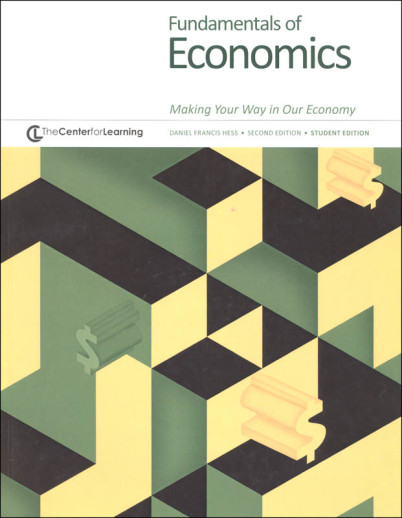We use cookies to make your experience better. To comply with the new e-Privacy directive, we need to ask for your consent to set the cookies. Learn more.
Fundamentals of Economics: Making Your Way in our Economy Student Workbook
By Daniel Francis Hess. These 70 activity-driven lessons form a semester-long survey course that teaches content knowledge through detailed readings supported by skill-building and critical-thinking challenges. The handout-driven lessons can lift out or serve as carefully scaffolded core curriculum in classrooms without an economics textbook. The curriculum's six units (Basic Economics, Business and Labor, Financial Institutions, Government and the Economy, Personal Finance, and Globalization) each kick off with a lively Socratic discussion, and the wide variety of activities aim to make economics engaging as well as illuminating. Sample lesson titles: "Starting to Graph," "Labor Supply and Labor Demand," "Monetary Policy for Beginners," "Keynes Versus Hayek," "Household Budget," and "Developing Economies." This edition builds CCSS information literacy skills and includes Internet-based activities that encourage students to consider sourcing reliability and evaluate information validity. The student worktext contains only the readings and worksheets, no teaching instructions. Grades 9–12. Bibliography.
Fundamentals of Economics is not your typical reading-then-regurgitation approach to economics. This course incorporates Socratic discussion and critical thinking skills, and relies on an invested teacher who is willing to enter into discussions. Furthermore, it interweaves topics and issues that touch upon national, global, and personal finance. Organized into six units, each unit starts with "Questions to Consider" and vocabulary terms you will need to know. Units cover these topics: Basic Economics, Business and Labor, Financial Institutions, Government and the Economy, Personal Finance, and Globalization. There are Readings and Handouts for each Unit. Readings are divided into multiple segments and provide topical overview, textual instruction, graphs, illustrations, and analysis. Each segment of the reading concludes with a discussion-based "Pressing Question." Next follows a series of Handouts each geared to a segment of the reading. These Handouts provide a wide variety of activities – everything from crosswords to review vocabulary, to in-depth analysis of a particular example. There are a number of handouts for each unit. For example, the Unit on Personal Finance includes 17 Handouts including one on Identity Theft. These Handouts often require independent internet research. The Student Workbook includes the Readings plus the accompanying Handouts. The Teacher Guide includes this same information (with answers) plus some additional information such as background info, objectives, and evaluation notes.
This is a well-organized and comprehensive, standards-based, one semester economics course. It does, however, require teacher investment and probably some additional preparation even though lessons are thorough. It is assumed that the student will be doing some additional web-based research. Student book is 245 pgs, pb. Teacher Guide is 335 pgs, pb. ~ Janice
| Product Format: | Paperback |
|---|---|
| Grades: | 9-12 |
| Brand: | Center for Learning |
| ISBN: | 9781560049777 |
| Length in Inches: | 10.75 |
| Width in Inches: | 8.375 |
| Height in Inches: | 0.5625 |
| Weight in Pounds: | 1.4 |
Be the first to review this item


I wanted to check it out.
One of the only secular/non-religious choices.